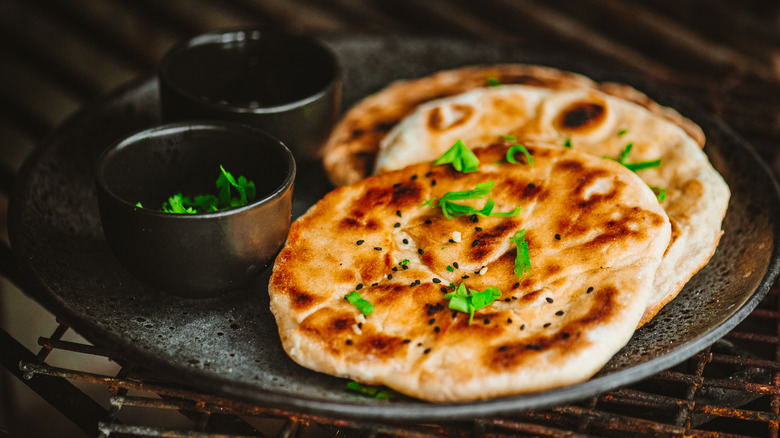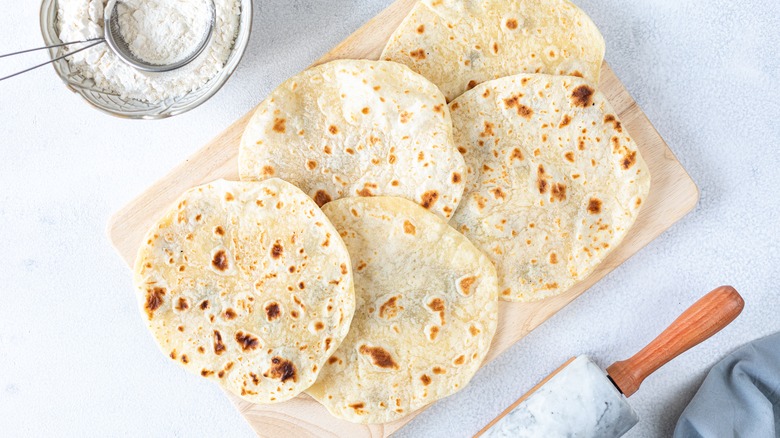Transforming Leftover Yogurt Into Fluffy Flatbread Is Almost Too Easy
Yogurt isn't just a delicious breakfast side, it's also packed with beneficial probiotics and nutrients. Because of this, it seems like everyone is eating yogurt, especially Greek yogurt. However, one downside to buying a giant container of yogurt is that it goes bad if you don't use it quickly. If you have yogurt in your fridge that needs to be consumed (and you don't feel like eating it plain), there's a great way to use up your leftovers so that they don't go to waste. While you can spoon some into a smoothie or mix it into a dip, one creative way to use the last of your yogurt is to make flatbread with it.
The quickest and easiest version only requires two ingredients: thick yogurt and self-rising flour. Some bakers experiment with a dough that is equal parts, while others favor a sturdier version with a 3 to 2 ratio of flour to yogurt. Either way, the results are toasty and tender whether fried in a skillet or baked in the oven.
This trick works so well because yogurt tends to make bread fluffier and moister while adding another layer of flavor with its slight sourness, which takes the bread to the next level with a taste reminiscent of sourdough. In fact, using thick natural yogurts like Greek yogurt or Icelandic skyr in bread is definitely not a new concept, and many recipes for naan – the Indian flatbread – call for plain yogurt instead of water or oil.
Why you should start adding yogurt to your flatbreads
While yogurt is a classic ingredient in certain flatbreads like naan, that doesn't mean you have to stick with tradition. In fact, yogurt tastes great in many flatbreads from around the world, from pita to tortillas. This works because the added yogurt actually creates a great environment for yeast to rise quickly. Yogurt also has a similar effect on flatbreads that don't include yeast because the acidity of the yogurt interacts with baking soda to help make your bread fluffy and soft. So, basically, no matter what flatbread you're making, yogurt can help.
To add yogurt to your favorite flatbread recipe, you can swap the water, milk, or oil for plain yogurt. If you are using Greek yogurt, a good ratio to start with is to replace every cup of oil with 1¼ cups of yogurt. Because flatbreads are savory, this trick often works best with plain yogurt that has a hint of sour flavor (like Greek yogurt or skyr). You can also get by with a sweetened vanilla yogurt, although your bread will be a little sweeter than normal. However, using fruit-flavored yogurts in flatbread probably won't yield tasty results unless you're making something like a raspberry Nutella naan pizza.
Yogurt is also great in gluten-free bread
If you suffer from Celiac disease or gluten sensitivity, then you know that finding a good gluten-free bread can be a challenge. However, yogurt may also help in this area as, according to a scientific study published by the National Library of Medicine, adding fresh yogurt to typical gluten-free bread recipes not only boosted the health benefits of the loaf but also increased the quality of the bread by making it softer and preventing staleness.
This study was done using typical store-bought gluten-free flour mixes. However, yogurt can also be helpful by providing extra lift to breads made from chickpea flour, which is naturally gluten-free but tends to bake into a dense and heavy flatbread. If you've never made chickpea flour flatbread, then it's definitely worth a try — especially with added yogurt and baking soda for lift. Start out by trying one of the oldest gluten-free breads, called socca, and see how the fermented dairy turns the pancake light and moist.


